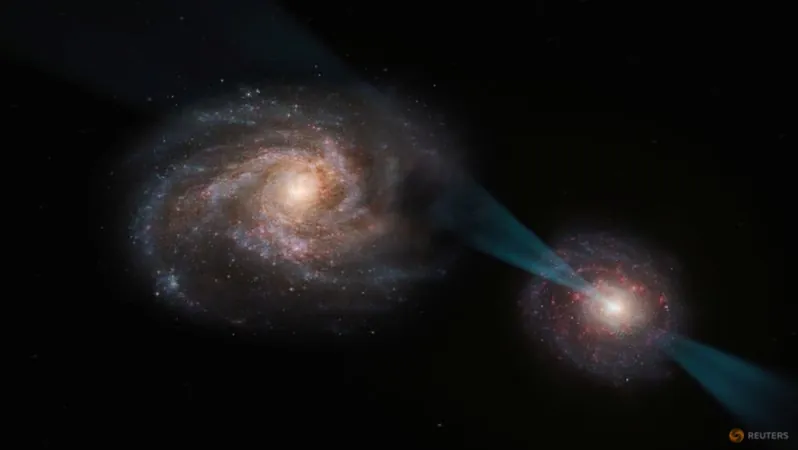
Galactic Showdown: Two Distant Galaxies on a Collision Course!
2025-05-21
Author: Daniel
In an astonishing cosmic spectacle, astronomers have uncovered two remote galaxies, each boasting a stellar population comparable to our very own Milky Way, racing toward a monumental merger! This thrilling event, reminiscent of knights clashing in a joust, took place when the universe was still a mere fifth of its current age.
Captured by state-of-the-art telescopes in Chile, these galaxies were observed as they existed about 11.4 billion years ago, just 2.4 billion years post-Big Bang. At the core of one galaxy lies a quasar—a highly luminous entity fed by gas and material spiraling into a supermassive black hole, unleashing an energetic explosion of radiation across the universe.
The quasar's intense light is wreaking havoc on the companion galaxy, disrupting its molecular clouds—crucial regions for star formation. According to leading astrophysicist Sergei Balashev, the quasar's cosmic onslaught has transformed these clouds into tiny fragments incapable of birthing new stars.
"It’s the first time such an extraordinary phenomenon has been documented," remarked Balashev, co-author of the groundbreaking study published in the esteemed journal Nature.
The researchers likened the two galaxies to jousting knights. "As they charge toward one another, the quasar-host galaxy releases a powerful beam of radiation that pierces its counterpart, much like a lance, wounding it by disrupting its gas," explained astronomer Pasquier Noterdaeme.
The quasar’s supermassive black hole, a staggering 200 million times the mass of our sun, exerts immense gravitational forces that pull material toward it, creating a radiation-emitting disk. As gas spirals inwards, friction intensifies, forming biconical beams of radiation that spell disaster for the neighboring galaxy.
Interestingly, this black hole dwarfs Sagittarius A*, the supermassive black hole at the center of the Milky Way, which is about 4 million times the mass of our sun.
Armed with advanced tools like the Atacama Large Millimeter/submillimeter Array (ALMA) and the European Southern Observatory’s Very Large Telescope (VLT), the researchers meticulously studied these galaxies, observing the quasar’s radiation directly ripping through its celestial companion.
Most galactic mergers we've seen occurred much later in cosmic history, but this discovery hints at a more dynamic universe where gravitational interactions could lead to such spectacular encounters even in its infancy. As these galaxies continue their high-speed approach, they are destined to merge into a larger entity, with the quasar gradually fading as it depletes its cosmic fuel.
Stay tuned, as the universe keeps unveiling its breathtaking stories of collision and creation!




 Brasil (PT)
Brasil (PT)
 Canada (EN)
Canada (EN)
 Chile (ES)
Chile (ES)
 Česko (CS)
Česko (CS)
 대한민국 (KO)
대한민국 (KO)
 España (ES)
España (ES)
 France (FR)
France (FR)
 Hong Kong (EN)
Hong Kong (EN)
 Italia (IT)
Italia (IT)
 日本 (JA)
日本 (JA)
 Magyarország (HU)
Magyarország (HU)
 Norge (NO)
Norge (NO)
 Polska (PL)
Polska (PL)
 Schweiz (DE)
Schweiz (DE)
 Singapore (EN)
Singapore (EN)
 Sverige (SV)
Sverige (SV)
 Suomi (FI)
Suomi (FI)
 Türkiye (TR)
Türkiye (TR)
 الإمارات العربية المتحدة (AR)
الإمارات العربية المتحدة (AR)